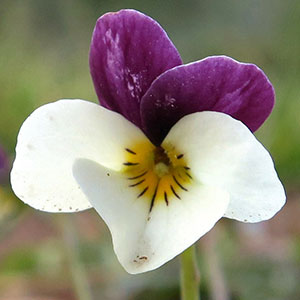Viola odorata
Viola hallii
English violet, garden violet, sweet blue violet, sweet violet, violette odorante
Hall's violet, Oregon violet, wild pansy
1–3, decumbent or ascending to erect, ca. 1/2 subterranean, glabrous, clustered on single, short, vertical, deep-seated caudex.
basal (and from stolons), 5–10, ascending to erect;
stipules lanceolate to linear-lanceolate, margins fimbriate, projections gland-tipped, apex acute;
petiole 2–17 cm, puberulent;
blade unlobed, ovate to orbiculate, 1.5–7 × 1.5–5 cm, base cordate, margins crenate, ciliate, apex obtuse to rounded, surfaces puberulent.
basal and cauline;
basal: 1–4, palmately compound, ± 2-ternate or 3-ternate, leaflets 3;
stipules adnate to petiole, forming 2 linear-lanceolate wings, unlobed, margins entire, apex of each wing free, acute;
petiole 5–8 cm, glabrous;
blade ovate to deltate, 2.8–6 × 2.6–6.5 cm, ± coriaceous, base tapered, ultimate lobes narrowly elliptic, lanceolate, or oblanceolate, 1–7 mm wide, margins entire, ciliate or eciliate, apex acute, mucronulate, surfaces glabrous;
cauline similar to basal except: stipules usually lanceolate, sometimes broadly ovate, ± leaflike, margins toothed;
petiole 1.3–6 cm;
blade 2–4.8 × 1.2–5.5 cm.
4–15 cm, puberulent.
2.5–11 cm, glabrous.
sepals narrow to broadly lanceolate, margins ciliate, auricles 3–4 mm;
petals deep to pale blue-violet, pale blue, or white on both surfaces, usually white basally, lateral 2 sparsely to densely bearded, lowest usually purple-veined, 12–22 mm, spur usually same color as petals, elongated, 5–7 mm;
style head beardless; cleistogamous flowers on prostrate or ascending peduncles.
sepals lanceolate to ovate, margins ciliate, auricles 0.5–1 mm;
petals: upper 2 almost black abaxially, dark reddish violet adaxially, lower 3 pale yellow, cream, or ± white, lateral 2 bearded, with deep yellow to orange patch basally, dark reddish violet-veined, lowest with deep yellow to orange patch basally, dark reddish violet-veined, 5–18 mm, spur yellow, gibbous, 0.5–2 mm;
style head bearded; cleistogamous flowers absent.
sometimes purple-flecked, ovoid, 5–8 mm, puberulent.
ellipsoid, 4–12 mm, glabrous.
brown, 3–4 mm.
light brown, shiny, 3.2–3.5 mm.
= 20.
= 60, 72.
Viola odorata
Viola hallii
Viola odorata occurs in small colonies; individual plants are interconnected by stolons.
The flowers of Viola odorata are noted for their fragrance; some plants are more fragrant than others. It is native to Eurasia and assumed to be introduced in North America where it is usually found in areas associated with human habitation, including parks, lawns, and roadsides. A substantial industry revolved around the commercial production of violets in England, France, and the United States from prior to 1895 and into the 1900s (R. E. Coombs 2003). Viola odorata is sometimes found in remote locations not easily explained by anthropogenic influence, for example, Clearwater Mountains, Idaho. It is available through the nursery trade and is cultivated as a garden plant and occasionally reported as an escape. Viola odorata is grown in southern France for essential oils used in perfumes, flavorings, and toiletries, and also for the production of the sweet, violet-colored liqueur called parfait amour (V. H. Heywood 1978).
(Discussion copyrighted by Flora of North America; reprinted with permission.)
Viola hallii was discovered on the grounds of Willamette University in Salem, Oregon, by Elihu Hall, a professor at that institution (V. B. Baird 1942). Leaves of V. hallii are similar to V. beckwithii.
(Discussion copyrighted by Flora of North America; reprinted with permission.)
- Local floras:
BC,
CA,
OR,
WA
- Local Web sites:
CalFlora,
CalPhotos,
Flora NW,
Go Botany,
IL Wildflowers,
MI Flora,
PNW Herbaria
WildflowerSearch
iNaturalist (observations)
USDA Plants Database
- LBJ Wildflower Center
- SEINet
- Plants of the World Online
- Encyclopedia of Life
- Wikipedia
- Google Image Search


